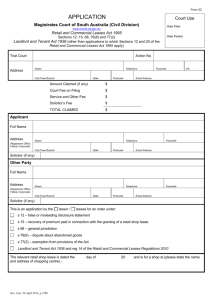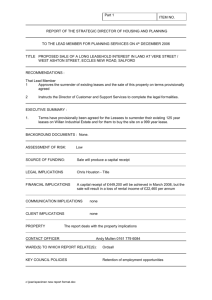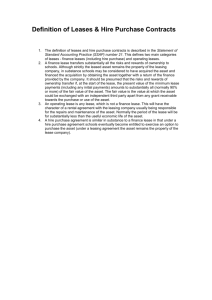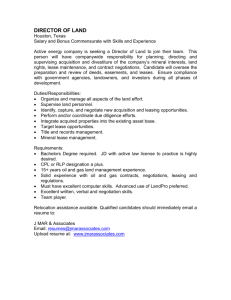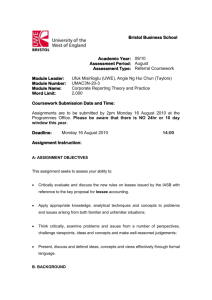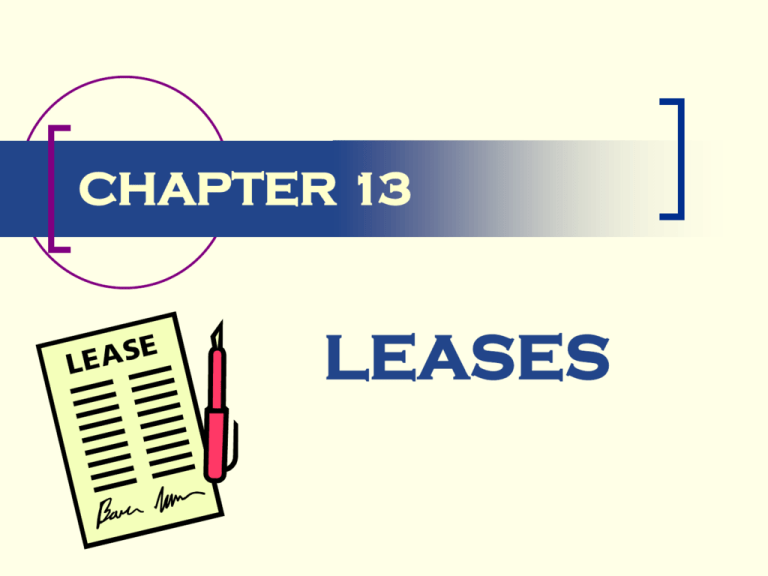
CHAPTER 13
LEASES
Introduction
Property rights are acquired by the
purchase of assets
Rights to use property are acquired
by leases
Some leases allow lessees to use
off-balance sheet financing of
assets
Advantages of Leasing
100 percent financing
Protection against obsolescence
Frequently less costly than other
forms of financing the cost of the
acquisition of fixed assets
Does not add debt to the balance
sheet
Management’s Choice Between
Purchasing and Leasing
Function of:
Strategic investment and
capital structure objectives
Comparative costs
Availability of tax benefits
Question:
When does the acquisition of rights to use
property become an in-substance property
right?
Types of Leases
Capital lease
lease is in substance a longterm purchase of an asset
Operating lease
lease is a rental agreement
What are decision criteria for deciding
whether a lease is capital or
operating?
Historical Perspective
ARB No. 38
APB Opinion No. 5
APB Opinion No. 7
APB Opinion No. 27
APB Opinion No. 31
Historical Perspective
Problems:
Criteria in these four APB Opinions did not
result in the capitalization of many leases
There was a lack of symmetry between lessee
and lessor accountings
Result: SFAS No. 13
Conceptual Foundation
of SFAS No. 13
Capital lease
transfers substantially all of the benefits and risks
of ownership from the lessor to the lessee
Conclusion
Must identify the characteristics that
indicate transfer of benefits and risks
Same characteristics should apply to
both lessors and lessees
Those leases that do not satisfy the
characteristics should be classified as
operating leases
Reasons Why Leasing May Be More
Attractive Than Buying an Asset
1 Period of use is short relative
to the overall life of the asset
2 Lessor has a comparative
advantage over the lessee in
reselling the asset
3 Corporate bond covenants of the
lessee contain restrictions relating to
financial policies the firm must follow
(maximum to debt to equity ratios)
4 Management compensation contracts
contain provisions expressing compensation
as a function of return on invested capital
Reasons Why Leasing May Be More
Attractive Than Buying an Asset
5 Lessee ownership is closely held
so that risk reduction is important
6 Lessor (manufacturer) has market
power and can thus generate
higher profits by leasing the asset
(and controlling the terms of the
lease) than by selling the asset
7 The asset is not specialized to the firm
8 The asset’s value is not sensitive to use or abuse
(owner takes better care of the asset than does
the lessee)
Criteria for Classifying Leases
For lessees
1 Lease transfers ownership of the
property to the lessee by the end of
the lease term
2 Lease contains a bargain purchase
option
3 Lease term is equal to 75 percent or
more of the estimated remaining
economic life of the leased property
unless the beginning of the lease term
falls within the last 25 percent of the
total estimated economic life of the
leased property
Criteria for Classifying Leases
4 Present value of the
minimum lease
payments at the
beginning of the
lease term
equals or exceeds 90
percent of the fair
value of the leased
property
less any related
investment tax credit
retained by the lessor
Recording Capitalized
Leases
For lessees
Present value of minimum lease payments is
computed and capitalized at lessee’s incremental
borrowing rate
unless lessor’s implicit rate is known and lower.
Minimum lease payments consist of:
1
2
3
4
Rental payments over the life of the lease
Any bargain purchase option
Any guaranteed residual value of the property
by the lessee
Any penalties for failure to renew the lease
by the lessee
Periodic expenses are interest expense
and depreciation on leased asset
Lease
Disclosures Required by Lessees
for Capitalized Leases
1 Gross amount of assets recorded
under capital leases
as of the date of each balance sheet
presented by major classes according to
nature or function.
2 Future minimum lease payments
as of the date of the latest balance sheet
presented
in the aggregate and for each of the five
succeeding fiscal years.
Disclosures Required by Lessees
for Capitalized Leases
3 Total minimum sublease rentals to
be received in the future under
noncancelable subleases
as of the date of the latest balance sheet
presented.
4 Total contingent rentals
rentals on which the amounts are
dependent on some factor other than the
passage of time
actually incurred for each period for
which an income statement is
presented.
Operating Lease
Operating leases
Income Statement
All leases which do
not meet any of the
four capitalization
criteria
Periodic payments
are recorded as rent
expense
Rent Expense
Disclosures Required for
Operating Leases by Lessees
1.
For operating leases having initial or remaining noncancelable
lease terms in excess of one year:
a)
b)
Future minimum rental payments required as of the date of the
latest balance sheet presented
The total of minimum rentals to be received in the future under
noncancelable subleases as of the date of the latest balance sheet
presented.
2.
For all operating leases
a)
Rental expense for each period for which an
income statement is presented
b)
with separate amounts for minimum rentals,
contingent rentals and sublease rentals.
Disclosures Required for
Operating Leases by Lessees
3
A general description of the lessee's leasing arrangements
including, but not limited to the following:
a
b
The basis on which contingent rental payments are determined.
The existence and terms of renewals or purchase options and
escalation clauses.
c
Restrictions imposed by lease agreements, such as those
concerning dividends, additional debt, and further leasing
Criteria for Classifying
Leases
For lessors
previous four criteria plus:
1
Collectability of minimum lease payments is
reasonably predictable
2
No important uncertainties surround the
amount of unreimbursable costs yet to be
incurred by the lessor under the lease
Sales-Type Leases
Involves manufacturer's or dealer’s
profit
Implication
Leased asset is an item of
inventory
Seller (lessor)
is earning a profit on the sale of the
property
as well as interest over the life of the
lease
Accounting by Lessors
Concern
Appropriate allocation of revenues and
expenses to the lease period
Capital leases are then classified by
lessors as either:
Sales-type
Direct financing
Direct Financing Lease
No profit is recorded at the
inception of the lease
Lessor is viewed as a lending
institution financing the purchase of
an asset
Revenue is interest earned
over the life of the lease
Disclosures Required by Lessors for
Sales Type and Direct Financing Leases
1.
2.
3.
4.
5.
6.
7.
8.
The components of the net investment in leases as of the date of
each balance sheet presented
Future minimum lease payments to be received
The unguaranteed residual value
Unearned income
Future minimum lease payments to be received for each of the
five succeeding fiscal years as of the date of the latest balance
sheet presented
The amount of unearned income included in income to offset
initial direct costs charged against income for each period for
which an income statement is presented (For direct financing
leases only)
Total contingent rentals included in income for each period for
which an income statement is presented
A general description of the lessor's leasing arrangements
Operating Leases
Do not meet criteria for
classification
as either sales-type
or direct financing leases are recorded
as operating leases by lessors
Periodic payments are recorded as
rent revenue and leased asset is
depreciated
Disclosures Required by
Lessors for Operating Leases
1 The cost and carrying amount, if different,
of property on lease or held for leasing by major classes
of property
according to nature or function,
and the amount of accumulated depreciation in total
as of the date of the latest balance sheet presented.
2 Minimum future rentals on noncancelable leases
as of the date of the latest balance sheet presented
in the aggregate
and for each of the five succeeding fiscal years.
3 Total contingent rentals included in income
for each period for which an income statement is
presented.
4 A general description of the lessor's leasing
arrangements.
Sale and Leaseback
Owner sells property and
then immediately leases it
back
Usually treated as a single
economic event
with the gain or loss on the
sale being amortized over
the lease term
Leveraged Leases
Three parties
Equity holder
Lessor
Asset user
Lessee
Debt Holder
Long-term financier
Leveraged Leases
Lessee periodic
payments assigned
to debt holders
Finances purchase
of assets
Financing Company
Transfer use
of the asset
Lessor
Lessee
FASB Decision on Accounting for
Leveraged Leases
Should transaction be recorded
as a single economic event or as
separate transactions?
Accounted for as a single
transaction
Accounted for as a capital lease
by the lessee and as a direct
financing lease by the lessor
Financial Analysis of
Leases
Company employing operating leases as opposed
to capital leases
will report a relatively higher working capital position
and relatively higher current and return on assets ratios
Analyze footnotes to a company’s financial
statements
to determine the impact of the use of operating leases its
financial position
Both Best Buy and Circuit City rely mainly on
operating leases to finance their retail outlets.
balance sheets do not fully disclose their long term
investments in property, plant and equipment
IAS No. 17
Amended to be effective 1/1/99
Added enhanced disclosure requirements
Requirements similar to SFAS No. 13
Difference in terminology –
Financial leases rather than capital leases for lessee
Terms sales-type and direct financing not used for lessors
FASB staff review indicated
while requirements were similar
ability to use judgment rather than
specific criteria make provisions
of IAS No. 17 somewhat optional
Prepared by
Richard Schroeder, DBA
Kathryn Yarbrough, MBA
Copyright © 2005 John Wiley & Sons, Inc. All rights reserved.
Reproduction or translation of this work beyond that permitted in
Section 117 of the 1976 United States Copyright Act without the
express written consent of the copyright owner is
unlawful. Requestsfor further information should be addressed to
the Permissions Department, John Wiley & Sons, Inc. The purchaser
may make back-up copies for his/her own use only and not for
distribution or resale. The Publisher assumes no responsibility for
errors, omissions, or damages, caused by the use of these programs
or from the use of the information contained herein.

